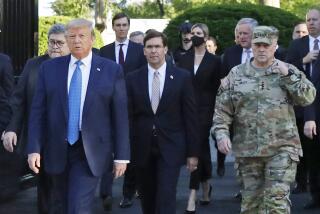Bush’s Promised Pentagon Reform Remains MIA
- Share via
Bureaucracies are inherently resistant to change, and none more so than the Pentagon’s.
In 1999, candidate George W. Bush declared that “our military is still organized more for Cold War threats than for the challenges of a new century.” He called for “a new architecture of American defense” and pledged “to move beyond marginal improvements--to replace existing programs with new technologies and strategies.” Running mate Dick Cheney, deploring the Clinton administration’s inadequate defense budgets, promised that “help is on the way.”
Certainly, President Bush took the right steps initially. Shortly after he took office, his new secretary of Defense, Donald Rumsfeld, ordered a no-holds-barred examination of virtually every activity performed by the Pentagon. Leaks to the media suggested that there might be cancellations of major weapons programs in order to finance long-range precision strike forces complete with space-based information systems. More unneeded military bases would be closed and armed services personnel management systems reformed, and the way we acquire weapons would be streamlined.
Sadly, eight months after Bush’s inauguration, real help has yet to arrive. What happened?
Rumsfeld made some initial mistakes. He was secretive. And he relied too heavily on either civilians or retired military personnel to evaluate the Pentagon, angering the military brass and their congressional allies, who, with the defense industry, coalesced into an alliance that so far has proved impregnable. This alliance has enormous vested interests in preserving, not cutting, Cold War weapons programs and forces. It might support Bush’s reform efforts were they to be financed by a big hike in defense spending, but that was never in the cards, given the sputtering economy and Bush’s huge tax cut. They are not about to finance transformation out of existing defense dollars.
Rumsfeld threw in the towel this month when he announced that the armed services themselves, not the Office of the Secretary of Defense, would determine how best to prepare for the future. But there are more obstacles to changing the military. Profound reform inside the Pentagon can be imposed only from the outside, by political intervention or foreign stimulus. Both are rare for the U.S., and neither applies at this moment.
On the domestic front, Bush has been preoccupied with his domestic political agenda, and now he must fight with the Democrats over who is responsible for the suddenly vanishing federal surplus. He seems unwilling to invest the time or political capital required to force radical change on the Pentagon. Indeed, with a resistant Congress and virtually no public pressure for radical change, why go looking for such a politically thankless fight?
Were we facing a hostile great power, reform might be more possible. Advocates of change believe China fits that bill, and that change is necessary to prepare for the inevitable emergence of China as our next great strategic rival. But it is way too early to tell about China. Simply put, there’s no sense of strategic urgency on the world front to fuel fundamental reform.
There is, too, the old argument, “If it ain’t broke, don’t fix it.” Cold War military technologies and organizations have performed well in the post-Cold War world. They have delivered successes in the Persian Gulf and the former Yugoslavia. If defeat in Vietnam provoked wrenching reform, victory against Iraq and Serbia has encouraged standing pat.
In sum, whatever the case to be made for major change at the Pentagon, the political and strategic prerequisites for it are missing. Congress is hostile; the White House is focused on other matters; the Pentagon is on a war-winning streak; and the United States faces no qualified military rival overseas.
We can expect change, therefore, to be evolutionary rather than revolutionary.
More to Read
Get the L.A. Times Politics newsletter
Deeply reported insights into legislation, politics and policy from Sacramento, Washington and beyond. In your inbox three times per week.
You may occasionally receive promotional content from the Los Angeles Times.










